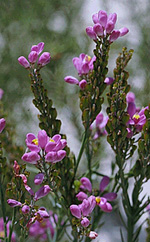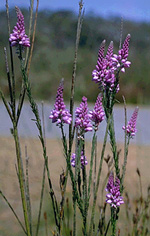 |
This family is almost worldwide in distribution, although relatively poorly represented in Australia where there are 3 native genera and one introduced one. Most species are found in heathlands, grasslands or shrubby open forests, rarely in the deserts or in closed forests. A few are environmental weeds.
Characteristic features of the family Polygalaceae in Australia include: - herbs, some twining, or shrubs with alternate, simple, entire leaves
- flowers zygomorphic, somewhat pea-like with two prominent "wings" formed by petal-like sepals and a keel-petal which is sometimes fringed or tufted
- stamens 5 or 8 (unlike true peas which have 10 stamens)
- ovary superior; fruit a flat, dry, papery capsule
Description
Evergreen shrubs, or perennial terrestrial herbs, or perennial
herbaceous vines climbing by scrambling, twining stems or by tendrils.
Tendrils axillary or terminating inflorescence axes. Perennating by taproots.
Leaves sometimes ±absent. Internal secretions not obvious or of
essential oils. Plants glabrous, or with simple, non-glandular, unicellular
hairs. Leaves well developed or much reduced (i.e. to scales, etc.), alternate
and spiral, cauline if herbs, petiolate. Stipules absent. Lamina simple,
symmetric, filiform, acicular, subulate, linear, lanceolate, ovate, elliptic,
oblanceolate, oblong or flabellate; base cuneate or attenuate; margins
entire, ±flat; venation pinnate, with the midrib conspicuous or
inconspicuous, and the tertiary venation reticulate; surfaces not punctate;
herbaceous or leathery. All the flowers bisexual. Inflorescences terminal
or axillary, consisting of spikes, racemes or solitary flowers. Bracts
present. Pollination by insects or birds. Flowers odourless; sessile or
stalked. Floral disc present or absent; nectaries present on the disc.
Perianth of 2 dissimilar whorls, imbricate in bud. Calyx regular or irregular;
segments fused, with 5 lobes; calyx cup-shaped, herbaceous. Corolla irregular;
segments fused, with 3–5 lobes, alternating with the calyx lobes; corolla
wheel-shaped or cup-shaped, 1-lipped or somewhat pea-flower-shaped, white,
cream, yellow or magenta, purple or violet, without contrasting markings,
membranous; claws absent; lobes ±entire. Fertile stamens 8, not
clearly correlated with the calyx lobes, free of the corolla, free of
the ovary and style, fused by their filaments into an open or closed tube,
all ±equal. Anthers basifixed, not versatile, opening inwards or
terminally by pores or by short slits, 1–2- or 4-celled. Ovary superior
and sessile. Carpels 2–5, fused; ovary with 2–5 locules. Style terminal,
single and unbranched with the stigma capitate. Ovules 1 per locule, stalked;
placentation apical. Fruit a dry dehiscent, loculicidal capsule, or a
dry indehiscent nut or samara, or a fleshy drupe; the perianth on the
maturing fruit deciduous, or dry and persistent. Disseminule macro-surface
featureless or with straight hairs; micro-surface ±smooth, brown
or grey, dull. Seeds 1–5 per fruit. Aril present or absent. Cotyledons
2. Embryo straight.
(Note: this description has been generated from the coded data compiled for the key. Any errors in the key data will be reflected in the descriptions.)
A treatment of the family Polygalaceae has not yet been published in the Flora of Australia. It will appear in Volume 24.
Australian genera of Polygalaceae (as recognised for the Flora of Australia)
† = some species native, others introduced
* = all species introduced
Comesperma
Emblingia
*Muraltia
†Polygala
Salomonia

|
  |

Comesperma ericinum (flowers)
Photo: M.Fagg © ANBG

Comesperma polygaloides (flowers)
Photo: J.Wrigley © ANBG

Comesperma retusum (flowers)
Photo: P.Ollerenshaw © ANBG

Comesperma virgatum (flowers)
Photo: E.Canning © ANBG

|
 |
|